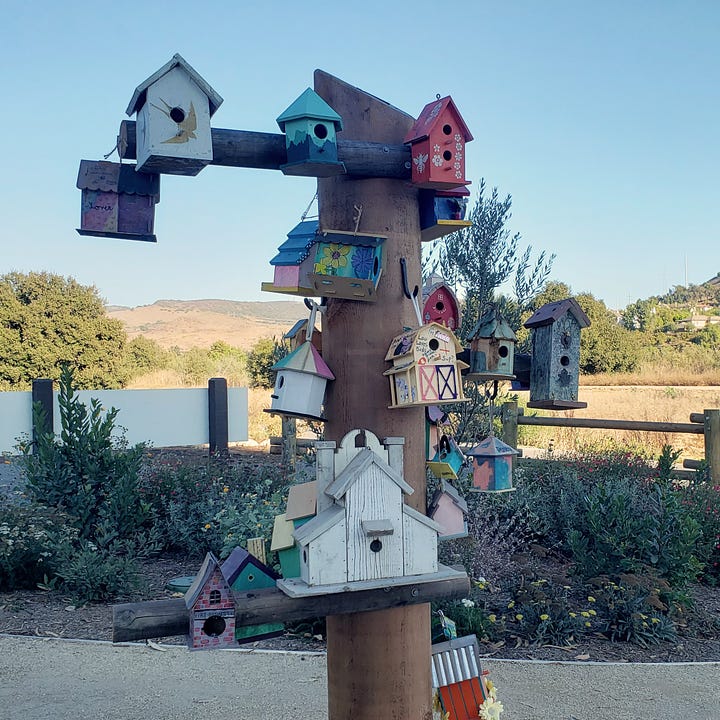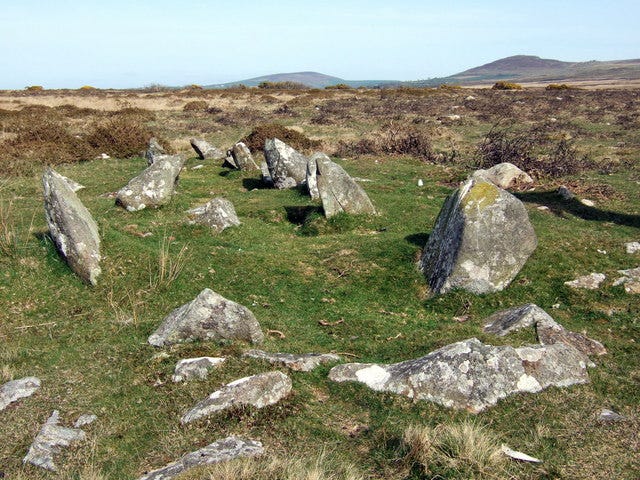I Finished the Second Draft of My Folklore-Inspired Novel :)
Plus, the legend of the afanc (a Welsh river monster)
Hello,
I hope this message finds you well. I have a few readers who live in states impacted by the recent hurricanes in the US. I hope you all are safe. My brother and his family live in Florida, and they had to evacuate for both hurricanes. Their carport was destroyed, and they suffered a small amount of flood damage. But they are safe and can still live in their home, so we are grateful for that.
As a quick update on the fires in our area that I wrote about last month, the fire near our home is 100% contained, and the other fires in SoCal are over 90% contained. That is good news, and we are so thankful to all of the fire crews for their help.
The weather has cooled here a little, and I’ve been able to take some nice walks. On one, I discovered a mini park that is dedicated to handmade birdhouses. So fun!


Behind the Scenes: I Finished the Second Draft of My Novel :)
I’m so excited! I recently completed the second draft of my folklore-inspired novel! It currently stands at 81,000 words in length. It’s a fantasy novel infused with faerie folklore and is set in an Earth-like secondary world, similar to the late 1800s UK and US. It explores the changeling legend from the parents’ perspective. And the topics of adoption and single parenting also play a significant role.
The next task will be editing the manuscript. I did a great deal of plotting, planning, and research while creating my first draft. So for the second draft, I’ve been essentially expanding each scene, writing them out in full. I’ve revised shorter works before, but never a full-length novel. However, I do have many a checklist from other authors and editors with suggestions of how to approach it, so I’m looking forward to this next stage of the writing process.
Exploring Folklore: The Legend of the Afanc
In Welsh folklore, the afanc is often described as a type of river monster. Depending on the legend or tradition, the afanc may take the form of an enormous beaver, a monstrous crocodile, or a worm (dragon). The word afanc appears to have changed meanings over time as well, which may account for the different versions of the creature.
The more I researched this topic, the more I came to see how complex the afanc is—his story is layered and found in legends as well as in early Welsh writings. In many of the tales, it often took great strength to overcome the afanc, and he wasn’t often destroyed, but instead relocated.
The River Conwy Afanc
The most complete afanc legend that I came across comes from Celtic Folklore: Welsh and Manx by John Rhŷs. Rhŷs provides an English translation of a portion of a letter written by Edward Llwyd dated 1693. The letter describes a legend regarding an afanc inhabiting a pool known as Llyn yr Afanc on the River Conwy. Local belief held that the afanc caused the river to flood, making it difficult for people to cross.

The legend begins with the afanc being drawn out of his hiding place by a maiden. (As a content warning, the afanc harms the maiden in this version of the story.) The translated legend opens in this way:
I suppose it very probable that you have heard speak of Llyn yr Afanc, “the Afanc's Pool,” and that I therefore need not trouble to inform you where it stands. I think, also, that you know, if one may trust what the country people say, that it was a girl that enticed the afanc to come out of his abode, namely the pool, so as to be bound with iron chains, whilst he slumbered with his head on her knees, and with the grip of one hand on her breast. When he woke from his nap and perceived what had been done to him, he got up suddenly and hurried to his old refuge [the pool], taking with him in his claw the breast of his sweetheart.
Oxen, along with some men, pulled on the iron chain, and drew the afanc from the pool. But with this success came a dispute: which of the men had pulled the hardest? While the men debated, the afanc himself resolved the issue by proclaiming:
Had it not been for the oxen pulling,
The afanc had never left the pool.
And with that, the oxen dragged the afanc away, heading toward a mountain lake. While some people thought this afanc was a demon, it was generally believed to be a huge beaver. The oxen pulled their heavy captive a long distance, and the strain caused one of the oxen to “drop” one of its eyes. A pool formed on the spot where the eye fell and was called Pwll Llygad Ych. It was a mysterious pool in that the water level remained constant and only knee-deep.
But the oxen continued on in spite of their hardship. They dragged the afanc through the mountains and finally reached Llyn y Ffynnon Las, a lake deemed dangerous, very deep, and like a whirlpool. They “consigned” him to the lake, and in doing so, were able to prevent the afanc from causing floods of the River Conwy.
Thinking back to my newsletter on the legend of the unicorn (which you can read here), I noticed that the afanc story and the unicorn story share a similar element—in both a maiden lures the creature to her lap where it falls asleep. I find this similarity surprising and wonder how common of a theme this is. If you know of other legends that include this trait, be sure to let me know.
Hu Gadarn Version of the Afanc Legend
I would be remiss if I didn’t mention that in some versions of the legend described above, the oxen are driven by a heroic figure named Hu Gadarn. Also known as Hu the Mighty, he originated in the Welsh Triads. Many of the Triads appear in authentic medieval Welsh manuscripts, but Hu Gadarn appears in some that were added by Iolo Morganwg in the 18th century and are considered to be forgeries. Some scholars have suggested that perhaps his additions were based on folklore or oral tradition from his time. It’s difficult to be certain, though, whether Hu Gadarn comes from tradition, or perhaps only influenced it.
The Afanc as a Crocodile or Dragon
As I mentioned earlier, the afanc doesn’t always appear in the same form. There are some legends where he appears as a terrible crocodile. In the article “Gwragedd Annwn—The Dames of Elfin Land” published in Archæologia Cambrensis, John Pughe writes briefly of a “mystic Afanc y Llyn, crocodile of the lake.” He explains that the mountaineers living in the vicinity of Llyn Barfog, a secluded mountain lake, claim that King Arthur (with the help of his warhorse) pulled the afanc from the lake. Evidence of this act can be found near Llyn Barfog, as Pughe explains:
… in proof of which is shown an impression on a neighbouring rock bearing a resemblance to those made by the shoe or hoof of a horse, as having been left there by his charger when our British Hercules was engaged in this redoubtable act of prowess, and this impression has been given the name of Carn March Arthur, the hoof of Arthur’s horse, which it retains to this day.
After reading this article, I was curious about the concept of the afanc as a crocodile. I looked through some of my reference books and made an interesting discovery. In British Goblins: Welsh Folk-lore, Fairy Mythology, Legends and Traditions, Wirt Sikes includes a crocodile afanc tale that suggests a connection between the afanc and dragons. He writes:
The terrible Crocodile of the Lake, which was drawn from its watery hiding-place by the … Oxen of Hu Gadarn, is also sometimes called a dragon (draig) in those local accounts which survive in the folk-lore of several different districts. It infested the region round about the lake where it lay concealed, and the mighty oxen so strained themselves in the labour of drawing it forth that one of them died and the other rent the mountain in twain with his bellowing.
This was the first time I’d encountered the suggestion that the afanc might be a dragon, and I was intrigued. So I continued researching. I didn’t find any more tales, but Katharine Briggs, in her book An Encyclopedia of Fairies: Hobgoblins, Brownies, Bogies, and Other Supernatural Creatures, also likens the afanc to worms (dragons). She explains that most British and Celtic dragons are worms. Several of the traits she uses to describe worms seem similar to the afanc: they are scaly, long, and wingless; they haunt pools; and they have a fondness for maidens.
The Grave of the Afanc
There are other afanc tales that differ a bit from the tradition described above. Bertram Lloyd describes one in his Folklore article, “Notes on Pembrokeshire Folk-Lore, Superstitions, Dialect Words, etc.” He shares a legend of an afanc dwelling in the Preseli Hills. He doesn’t describe the creature’s appearance, but explains that it would attack livestock, so the local people devised a plan “to slay him by a trick.” They convinced the afanc to dig a deep well for them. Once he was quite far down in the hole he’d dug, the people dropped a load of stones on top of him, hoping to crush him. But the afanc kept digging, unfazed by the stones. Eventually he died a “natural death” and was buried on the hillside with a stone circle marking his tomb (Bedd yr Afanc).

The Afanc in the Mabinogion
Finally, the afanc also makes an appearance in the tale “Peredur son of Efrog” in the Mabinogion. In Lady Charlotte Guest’s version, she uses “Addanc” as the translation for afanc, but Sioned Davies simply uses the term “monster.” He is not physically described, but in this story he lives in a cave, which has a stone pillar at its entrance that he hides behind. He can see those who approach without being seen and kills all who comes near with a poisoned spear. However, Peredur is given a special stone from a maiden, which allows him to see the afanc on entering the cave, but the creature doesn’t see him. Davies translates the afanc’s final moments in this way:
Peredur came to the cave, and took the stone in his left hand and the spear in his right hand. And as he entered he saw the monster and thrust a spear through him and cut off his head.
On a side note, I’m intrigued by the stone given to Peredur. It reminds me of a self-bored stone (one with a hole in it created by the action of water) with which a person could look through to see faeries.
But beyond that, this story is unique in that Peredur clearly destroys the afanc. In many of the legends, the afanc is only able to be relocated. John Rhŷs explains that there are similar traditions to the River Conwy afanc (the first tale I related above) where people tried to kill the creature, but it was in vain. He writes, “… no harpoon, no arrow or spear made any impression whatsoever on the brute's hide ; so it was resolved to drag it [the afanc] away ….”
And in the same way, the afanc legend lives on. He even seems to be making appearances in popular culture such as The Lord of the Rings Online video game, the book Silver on the Tree by Susan Cooper, and the Merlin television show.
As ever, thank you for subscribing and reading.
All the best,
Steph
PS: While looking for art to include in this letter, I found a storytelling video that gives another version of the Pembrokeshire afanc. It’s short and fun, if you’d like to watch:




Another great read and congratulations on finishing your first draft 🙌🏻
I've loved taking this little dive, with you, in the stories of the afanc--thank you! And congratulations on completing your second draft. Well done!